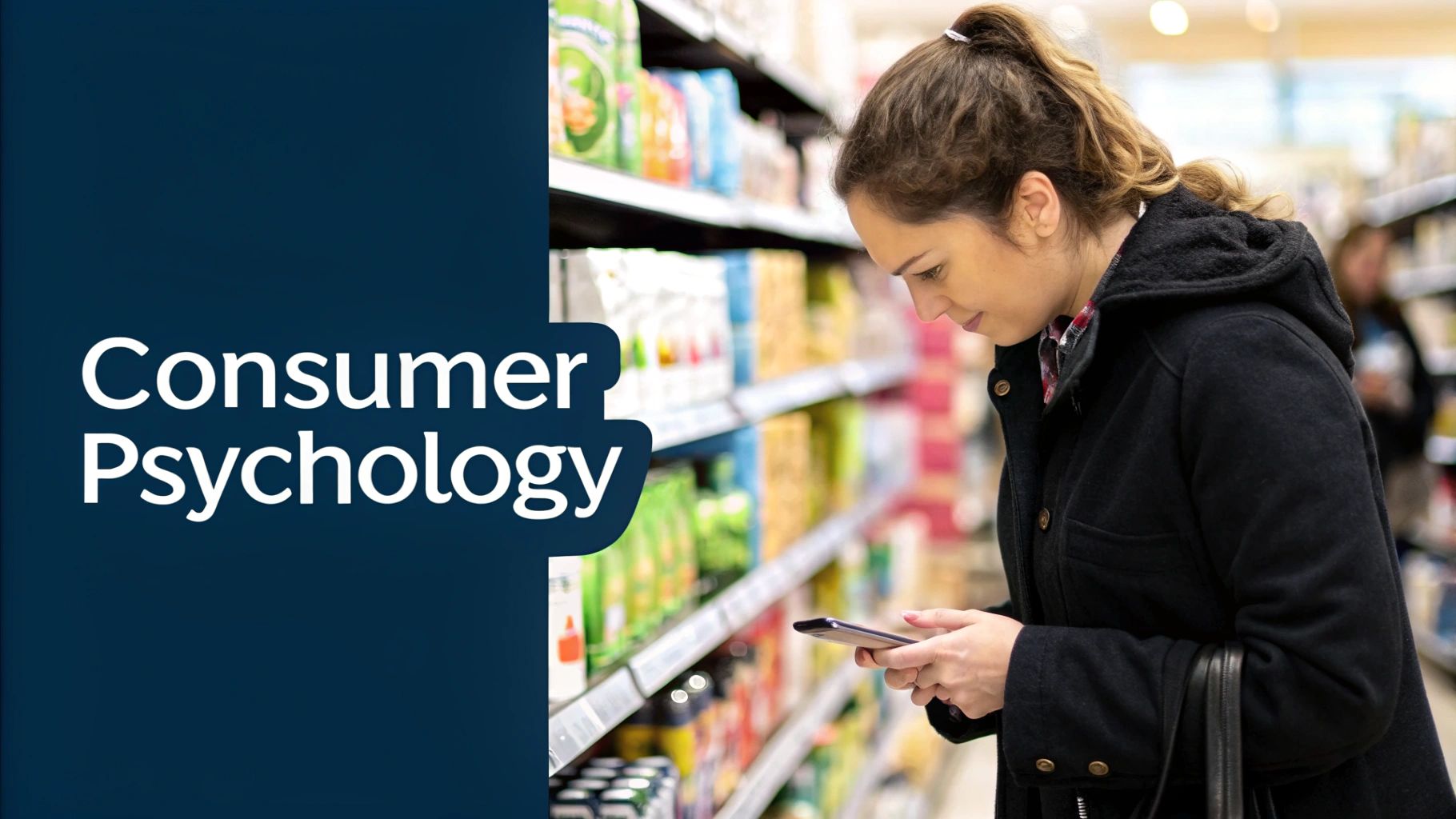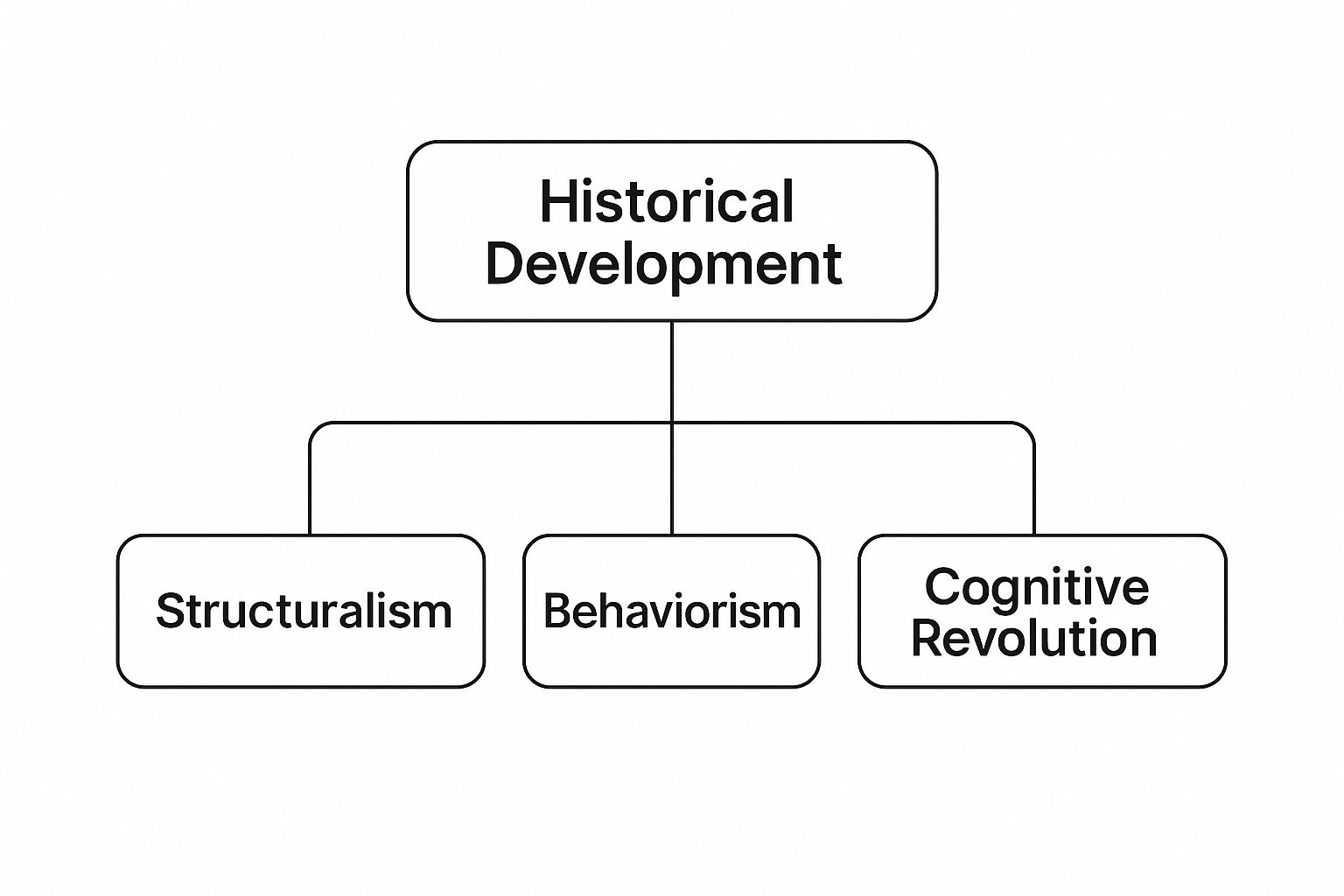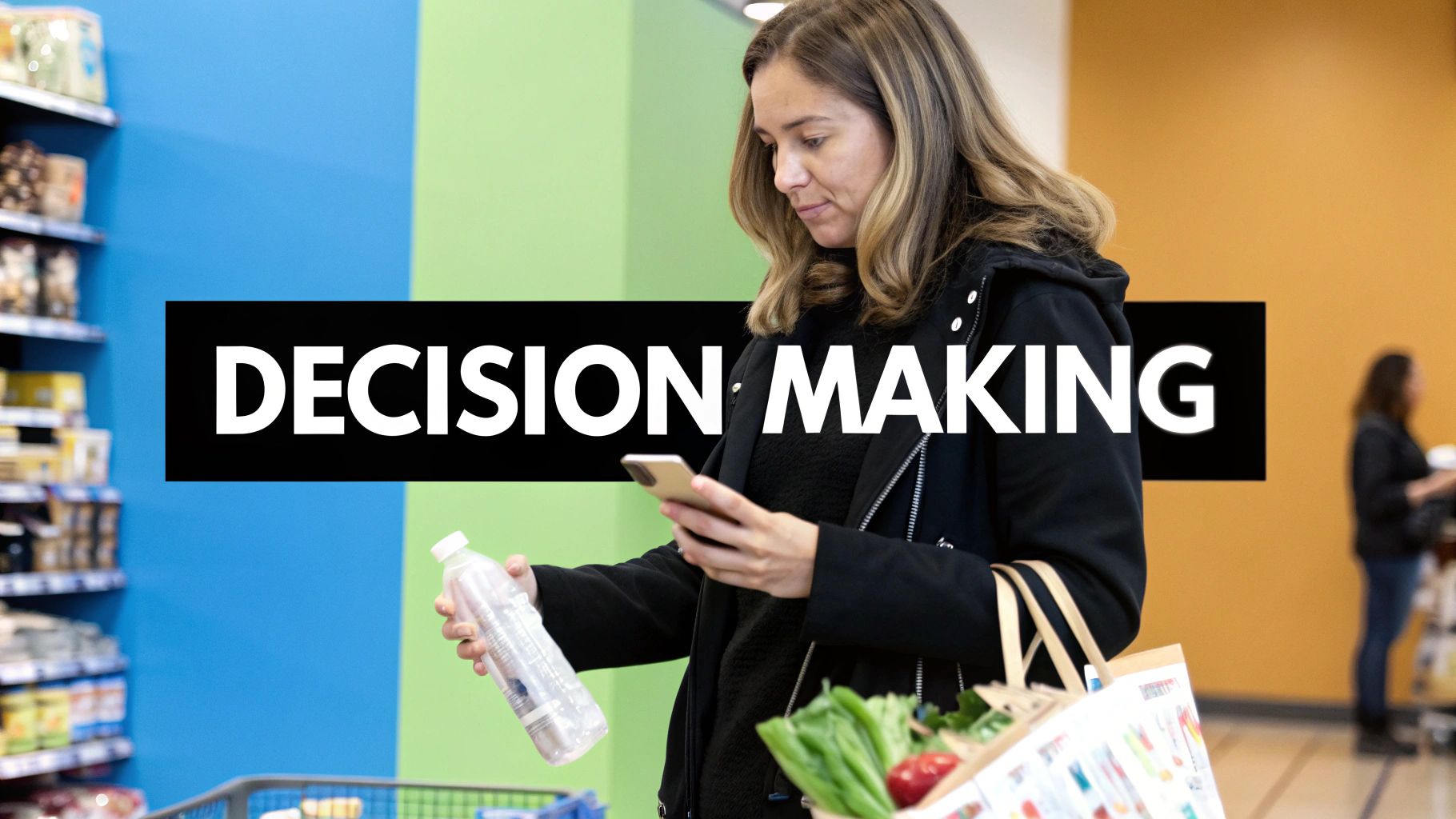
At its heart, consumer psychology is the study of why people buy things. It's a fascinating look into the hidden thoughts, deep-seated feelings, and subtle social pressures that guide our choices every single day—from the brand of coffee we grab at the store to the streaming service we decide is worth our monthly subscription.
What Is Consumer Psychology in the Real World?

Think of a consumer psychologist as a kind of behavioral detective. Their job isn't just to note what someone bought. It's to uncover the intricate web of clues—the motivations, emotions, and mental shortcuts—that led to that specific purchase. Why did one person splurge on a luxury handbag while another chose a practical, no-frills tote? What invisible force made someone click "add to cart" on an item they weren't even searching for five minutes ago?
This is where consumer psychology goes deeper than traditional market research. Market research is great at telling us what people do, but consumer psychology is obsessed with the why and the how.
A classic study perfectly illustrates this. Researchers found that people overwhelmingly preferred nylon stockings placed on the right-hand side of a display. Yet, when asked why they chose that specific pair, not a single person mentioned its position. They offered all sorts of rational reasons, like texture or quality, completely oblivious to the real, subconscious nudge that guided their hand.
This reveals a core truth about human behavior: we often have no idea why we really do things. Our conscious, logical explanations are frequently just stories we tell ourselves to make sense of decisions driven by much deeper, invisible forces.
Key Insight: Consumer psychology is all about unpacking the mystery behind our buying habits. It examines the mental wiring, hidden desires, and emotional triggers that truly dictate our actions in the marketplace.
To really get to grips with what makes us tick as shoppers, consumer psychology investigates a few fundamental areas. These pillars form the bedrock of the entire field.
The Core Pillars of Consumer Psychology
| Pillar | Area of Focus |
|---|---|
| Cognition | How do we think? This pillar explores the mental shortcuts, memory, attention, and problem-solving processes we use when evaluating products. |
| Emotion | How do we feel? It investigates how feelings—like joy, trust, excitement, or even fear of missing out—color our perceptions and drive decisions. |
| Motivation | What do we want? This looks at the underlying needs and desires, both conscious and subconscious, that a purchase is meant to fulfill. |
| Social Influence | Who are we with? This examines how our choices are shaped by friends, family, culture, social norms, reviews, and influencer recommendations. |
By exploring these foundational pillars, we start to see how a complex mix of thinking, feeling, and social pressure comes together every single time we shop.
Ultimately, understanding what consumer psychology is isn't about trickery or manipulation. It’s about empathy. When a business truly grasps these psychological drivers, it can create better products, design more intuitive and enjoyable shopping experiences, and communicate in a way that genuinely connects.
For a bustling online marketplace like FindTopTrends, where countless products are vying for your attention, this understanding is everything. It helps us see the bigger picture behind every click, scroll, and purchase.
The Four Key Principles Driving Our Choices
Very few of our buying decisions happen in a vacuum. Most of the time, they’re guided by a powerful set of psychological principles working just below the surface of our conscious minds. To really get a handle on what consumer psychology is, we need to look at these core drivers that shape our journey from just browsing to actually buying.
Think of these principles as invisible scripts that steer our choices in surprisingly predictable ways. Once you start to recognize them, you'll see exactly why you're drawn to certain products and why some marketing messages just seem to click.
Cognitive Biases: The Brain's Shortcuts
Our brains are built for efficiency. To keep from getting bogged down by the endless stream of decisions we face every day, we rely on cognitive biases—think of them as mental shortcuts that help us make choices fast. They're incredibly useful, but they can also lead us down very specific, sometimes irrational, paths.
- Scarcity Effect: Ever seen a "Only 2 left in stock!" notification and felt a sudden, almost primal, urge to buy? That's the scarcity effect in action. When something is limited, our brain automatically assigns it more value because we're afraid of missing out.
- Social Proof: We're social animals, hardwired to look to others for clues on how to behave. When a product boasts thousands of glowing reviews or we see an influencer we admire using it, our brain flags it as a safe and desirable choice. This is precisely why testimonials and user-generated content are so powerful.
Often, these shortcuts team up. A limited-time discount on a "bestseller" combines scarcity with social proof, creating a potent combination that strongly nudges you toward hitting that "buy now" button. To see how brands create this urgency online, it's worth reading more about the psychology of time-driven marketing.
Emotional Triggers: The Heart's Influence
Let's be honest: logic is often just along for the ride. When it comes to making decisions, our emotions are usually in the driver's seat. Feelings have a knack for overpowering rational thought, and the most successful brands are masters at connecting with us on an emotional level.
A purchase can be sparked by anything from the sheer joy of unboxing a new gadget to the deep sense of relief from finding the perfect gift. One of the most common emotional drivers is the fear of missing out (FOMO), which convinces us that we'll regret it forever if we don't act right now. Trust is another big one. Brands that build a solid reputation for being reliable and caring for their customers foster a sense of safety that turns one-time buyers into loyal fans.
Key Takeaway: Emotional connection isn't just a nice-to-have; it's a core part of the customer experience. A brand that makes you feel understood, excited, or secure has already won half the battle.
Social and Personal Factors
Who we are—and who we hang out with—profoundly shapes what we buy. The products we choose often become a reflection of our identity, our values, and our social circles.
- Social Influence: A recommendation from a friend, family member, or a community you trust carries enormous weight. That personal endorsement can cut through all the marketing noise and instantly validate a brand in your mind.
- Personal Factors: Our lifestyle, personal values, and even our income level set our priorities. Someone passionate about sustainability will go out of their way to find eco-friendly products, while a budget-conscious parent will naturally gravitate toward items that offer great value and durability.
This infographic captures how our understanding of these complex consumer drivers has evolved over time.

As you can see, the field grew from simply studying mental "structures" to observing tangible behaviors, and finally to understanding the cognitive processes that connect the two.
How External Forces Reshape Buying Habits
It’s easy to think of shopping as a purely personal choice, but our decisions never happen in a vacuum. We're all being influenced by powerful currents flowing through society—things like economic shifts, cultural movements, and major world events. These aren't just abstract headlines; they actively shape what we value and how we choose to spend our money.
Think of it this way: a swimmer can decide where they want to go, but the river's current will always affect their path. As consumers, we're the swimmers, and these big external forces are the current. They don't make our decisions for us, but they absolutely change the game.
The Influence of Global Concerns
In an age where we're all hyper-connected, global anxieties have a direct line into our shopping carts. Big-picture issues like health crises, economic instability, and environmental sustainability are no longer distant problems—they’re personal, and they guide what we buy and which brands earn our trust.
A report from Innova Market Insights for 2025 really drives this home. It found that widespread stress over these very issues is profoundly reshaping buying habits. For many, environmental concerns now top the list, largely because people are seeing the effects of climate change firsthand. This has created a huge push toward brands that align with people's values, turning sustainability from a "nice-to-have" into a genuine reason to choose one product over another. You can see more of their research on the Innova website.
The bottom line? A brand’s eco-friendly practices or its position on social issues isn't just a side note anymore. It's becoming a central part of what makes it valuable to a growing wave of consumers.
Economic Realities and Mindful Spending
Nothing reshapes buying habits quite like economic pressure. When money gets tight, we don't just look for cheaper options; our entire mindset shifts toward being more deliberate and value-conscious. It’s a psychological pivot to what you could call mindful consumption.
This shows up in a few key ways:
- A Focus on Longevity: People might spend more upfront on a high-quality, durable product because they know it will outlast a cheaper, disposable one. It's a calculation of long-term value.
- The Appeal of Versatility: A product that can do three things well is suddenly far more attractive than three separate products. It's about getting more bang for your buck.
- Deeper Brand Scrutiny: Shoppers are more likely to dig into a company's reputation before they buy. They want to make sure their hard-earned money is going to a brand they can truly stand behind.
Key Takeaway: External pressures push people to be more intentional. They aren't just buying stuff; they're making careful investments in their values, their health, and their financial future.
This constant dance between our inner psychology and these huge external trends is changing the market in real-time. To see exactly how this is impacting stores and online shops, check out our guide to the current trends in retail. The businesses that truly get it—the ones that understand the world their customer lives in is just as important as the customer themselves—are the ones that will build connections that last.
Understanding the Modern Hybrid Consumer

If you're still using the consumer psychology playbook from a few years ago, it's time for an update. Major global shifts have completely rewired how people shop, giving rise to a new, more complex type of buyer: the hybrid consumer.
This isn't just a fleeting trend. It’s a deep, psychological shift. These shoppers are full of fascinating contradictions. One day they’re meticulously hunting for deals on everyday essentials, and the next, they’re dropping a significant amount of money on a single luxury item. It’s a mix of bargain-hunting and splurging that can seem random, but it’s anything but.
The Cautious Indulgence Mindset
So, what’s going on inside the mind of this hybrid shopper? Their decisions are actually strategic trade-offs, born from a world that feels much less predictable. This lingering uncertainty has forced people to take a hard look at what they truly value.
Value isn't just about the lowest price anymore. It’s a much broader concept that now includes convenience, long-lasting quality, or something that brings a little joy into their lives. This is why you'll see someone buy the store-brand paper towels but then invest in a high-end kitchen gadget that makes cooking more fun. They're making conscious choices about where to save and where to spend.
This isn't just a hunch; the data backs it up. A report on the 2025 consumer from McKinsey highlights that even as the world has moved on from the pandemic, these mixed spending habits are here to stay. People aren't just cutting back across the board. They’re making sophisticated choices—trading down on some things to free up cash to splurge on others. It’s a fascinating dance between practical needs and emotional wants. You can dig deeper into these consumer insights on McKinsey's website.
Adapting to the New Consumer Reality
For anyone selling online, this hybrid mindset is a game-changer. You can no longer neatly sort customers into "budget shoppers" and "luxury buyers." The same person is often both, just at different times and for different products. This new reality requires a much more nimble and understanding approach.
Key Insight: The modern consumer isn't just buying things. They are carefully curating a lifestyle by balancing practical needs with personal desires.
To connect with these shoppers, you have to appreciate their complex motivations. You need to show them how your product is both a smart, sensible purchase and something that will genuinely make them feel good. The brands that can speak to both sides of this coin—the cautious and the indulgent—are the ones that will win.
Applying Psychology to Digital Experiences
Knowing the theories behind consumer psychology is one thing, but the real magic happens when you put them into practice. For any online business, the goal is to create a digital experience that feels intuitive, trustworthy, and genuinely helpful. This means designing a journey that works with the natural flow of the human brain, not against it.
Think of a poorly designed website as a cluttered room you're trying to navigate in the dark. Every confusing menu or slow-loading image is an obstacle you bump into, creating friction and frustration. Applying psychology is like turning on the lights and clearing a path—you're removing those obstacles and guiding visitors smoothly from discovery to checkout.
This all starts with a foundation of trust. High-quality visuals are completely non-negotiable; they're often the very first signal of a brand's credibility. In the same way, your product descriptions need to speak to both sides of the brain—the logical side that craves specs and details, and the emotional side that wants to feel how a product will improve their life.
Designing an Intuitive Customer Journey
A truly great e-commerce experience feels effortless. This is no accident. It's achieved by deliberately reducing cognitive load, which is just a technical term for the amount of brainpower someone has to use to navigate your site. The less a customer has to think about how to find something, the more mental energy they can spend discovering products they'll actually love.
A fantastic way to put consumer psychology into practice is by exploring interactive video marketing strategies that can turn passive viewers into active participants. This approach directly taps into our innate desire for engagement and personal connection, making the shopping experience much more memorable.
Key Principle: The best digital experiences are invisible. They guide users so naturally that the interface just fades into the background, letting the products and the brand's story take center stage.
This is precisely why social proof and personalization are so powerful. Seeing genuine reviews from other happy shoppers validates a potential purchase, while personalized recommendations make a user feel seen and understood. Both tactics chip away at uncertainty and build the confidence someone needs to click "buy."
From First Click to Final Purchase
The entire shopping journey is really just a series of psychological touchpoints. Each one is a chance to build more trust and momentum, paving the way for a frictionless final step. Here are three critical stages where applying these principles can make a huge difference:
-
Crafting Compelling Product Pages: Don't just list features; explain how each feature solves a problem or makes life better. Pair that benefit-driven copy with clear, high-resolution images that let people imagine the product in their hands.
-
Building Trust with Social Proof: Make your customer ratings, testimonials, and user-submitted photos impossible to miss. This taps into our powerful tendency to follow the crowd, reassuring new customers that they're making a smart choice.
-
Streamlining the Checkout Process: A clunky, confusing checkout is the number one killer of sales. Keep it simple. Offer a guest checkout option, show a clear progress bar, and never, ever spring surprise fees on someone at the last second.
Ultimately, these strategies are all about showing respect for your customer's time, attention, and values. For instance, a shopper searching for eco-friendly products wants to easily find and verify a brand's claims. If you want a deeper dive into this specific mindset, our guide on how to shop sustainably is a great resource.
By aligning your digital experience with these deep-seated psychological drivers, you create a journey that feels less like a cold transaction and more like a helpful conversation.
The Challenge of the Quiet Consumer

For decades, businesses had a pretty straightforward way to figure out what customers wanted. If someone loved a product, they'd tell their friends. If they hated it, they might write a letter or call customer service. But that’s changing. Today, the modern consumer is going quiet, and it’s creating a dangerous gap for anyone trying to understand them.
This silence doesn't mean everyone is happy. Far from it. Many people are just experiencing feedback fatigue—they’re simply worn out by the constant barrage of emails asking for reviews and pop-ups demanding a survey. So, they’ve clammed up, leaving brands guessing about what they really think.
Listening to Actions, Not Words
To get to the heart of consumer psychology today, we have to look past what people say and start paying close attention to what they do. This is where implicit feedback comes in. Think of it as the trail of digital breadcrumbs every shopper leaves behind as they move through a website.
These unspoken clues are everywhere if you know where to look. Implicit feedback includes things like:
- Browsing Habits: Which product pages do they keep coming back to? How much of a product video do they actually watch?
- Hesitation Clicks: Do they add something to their cart, only to immediately remove it? That hesitation is a powerful signal.
- Cart Abandonment: Where exactly in the checkout process do they bail? Was it right after shipping was calculated?
Each of these actions tells a story. A shopper who keeps looking at an expensive camera but never buys might be wrestling with the price or hoping for a sale. Someone who ditches their cart the moment shipping fees appear is almost certainly reacting to an unexpected cost. By learning to decode these subtle signals, you can start to understand the quiet consumer. In fact, spotting these patterns yourself is a big part of our guide on how to shop smarter and get more for your money.
Why Public Feedback Isn't What It Used to Be
Shifting focus to behavior isn't just a clever new strategy; it’s a survival tactic. The data shows a sharp drop in the kind of public feedback companies once relied on. For example, while a massive 64% of consumers say they want personalized shopping experiences, very few are using public channels to voice what they want.
Only 16% of consumers now complain on social media, a huge drop from just a few years ago. Similarly, just 22% bother writing reviews on third-party sites. This tells us that actions—what people click on, what they ignore—are becoming a much more honest gauge of their feelings than their words.
This data, which you can explore further in the full global consumer trends report from Qualtrics, points to a fundamental change in how people interact with brands. To truly grasp modern consumer psychology, we have to become experts at reading behavior to anticipate needs and make people happier—often without them ever saying a word.
Got Questions? Let's Talk Consumer Psychology
We've covered a lot of ground, but you might still have a few questions buzzing around. Let's clear up some of the most common ones people ask about how all this works in the real world.
How Is Consumer Psychology Different from Regular Psychology?
Think of it this way: general psychology is the big, sprawling map of the human mind. It studies everything from memory to social interaction. Consumer psychology zooms in on one specific, fascinating territory on that map—the marketplace.
It takes those broad psychological principles and applies them directly to how we behave as shoppers. It’s all about getting to the heart of why we choose one brand over another, what makes us click "buy now," and even what we're thinking when we toss out an old product.
Is It Ethical to Use This Stuff in Marketing?
That’s a great question, and the answer really comes down to intent. Is it being used to help or to manipulate?
Using psychology to truly understand what customers need, to build better products that solve their problems, and to create a genuinely positive experience is absolutely ethical. Where it crosses the line is when it’s used to deceive people—creating false urgency or exploiting known biases to trick someone into a purchase that isn’t right for them.
The bottom line: It’s ethical when it’s about connection and improvement. It’s unethical when it’s about exploitation.
What's One Simple Tactic a Small Business Can Use Right Now?
Focus on social proof. It's one of the most powerful and honest tools you have.
Simply making customer reviews and testimonials front and center on your website can work wonders. When a potential buyer sees that real people have already bought your product and loved it, it instantly lowers their guard. It builds trust and makes them feel much more confident in their decision.
Do These Principles Work for B2B Sales, Too?
You bet they do. At the end of the day, a B2B buyer is still a person.
Sure, the decisions might be more complex, involving more people and a focus on ROI. But emotions like the fear of making a costly mistake, the desire to look good to a boss, or the influence of what other companies in their industry are doing are always at play. Trust, relationships, and reputation are just as critical, if not more so.
Ready to see how these ideas play out with real products? Head over to FindTopTrends to explore what's currently catching the eye of shoppers everywhere. It's the perfect place to spot these psychological principles in the wild. Find your next favorite product on FindTopTrends.










